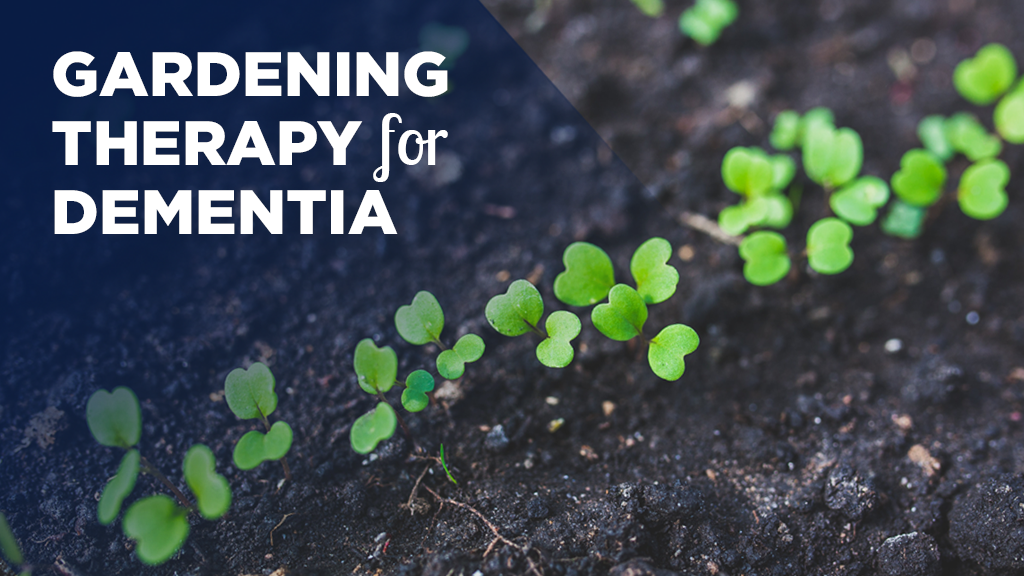
Gardening therapy for dementia
For someone who loves gardening, there is nothing like the meticulous, careful work of planning, planting and caring for a garden. The creative and tactile experience of being near to nature is not only good for our well-being, but it may in fact help to relieve the symptoms associated with Alzheimer’s disease and other dementias.
Living well includes many lifestyle factors, including diet, exercise, social contact and more. All of these can improve our cognitive health, no matter our age. For people who are living with dementia, well-being is also tied to the ability to enjoy familiar activities, and which cultivate a feeling of comfort. Garden therapy is at the top of that list.
A good care plan maximises the opportunity for independent activities, while providing plenty of opportunities for growth and self-improvement. Gardening provides a non-pharmacological approach toward these goals and may improve the quality of life for people who are living with dementia. As a care solution, support services that include social outlets, like gardening, reduce the need for more intrusive—and expensive—care solutions.[i]
In a recent literature review, researchers concluded that there are many benefits of horticultural therapy and garden settings. These include the reduction of pain, improvement in attention, lessening of stress, alleviation of agitation, lower use of medications such as antipsychotics and reduction of falls.[ii]
Where to begin? And what types of garden activities are most appropriate for someone who is living with dementia?
Healing garden activities for people living with dementia
Participating in gardening activities is possible at every stage of progression. At any stage, one’s environment can be adapted to better support someone who is living with dementia. Everyone can benefit from the sense of well-being that comes with gardening.
Gardening in early stage dementia
People who are in the early stages of dementia retain many of their functional capabilities and require minimal assistance with gardening tasks. In this stage, all gardening activities may be appropriate. From planning to planting, weeding and picking—all activities are possible! The key is to highlight the social aspects of the activity. Whether being part of a gardening club, or simply having a space to share with friends and family, gardening is a great therapeutic intervention to encourage feelings of well-being.
Gardening in middle stage dementia
People who are in the middle stages of dementia may need some assistance with daily tasks, however, the familiar and tactile elements of gardening will become a great complement in a care plan. In this stage, interactive garden features such as bird-feeders, raised garden beds, and bird baths will maximize the sensory and social aspects of gardening.
Gardening in late stage dementia
People in the late stages of dementia will have experienced a significant deterioration of their ability to care for themselves. However, with adequate paths and lighting, people who are living with dementia and are still mobile may still enjoy simply being in the garden, walking the paths with the help of a care partner. If mobility is limited, wheel-chair access into the garden with a care partner will still help them access many of the therapeutic benefits of being in nature. If mobility is significantly restricted, a sensory garden tub in their living space may be a great alternate.
No matter the stage of progression, there is no reason that gardening cannot be accessible. Learn more about what to expect in different stages of progression here.
Dementia friendly design considerations
According to a recent study, in order for a garden therapy initiative to be successful, it must be adapted to a population who is living with dementia[iii]. Here are some design considerations for your dementia-friendly garden:
- Therapeutic gardens should contain familiar elements that are typical of the region and from previous stages of their lifetime.
- A therapeutic garden should allow daily access and an enclosed perimeter to discourage accidental wandering.
- Ensure that the garden is accessible, well lit, and structured to reduce disorientation. This includes eliminating dead-ends.
- Include safety features to reduce falls. Non-slip, even pathways and railings are excellent ways to help people who are living with dementia navigate the garden with ease.
- Include a variety of plants to promote visual, olfactory and tactile stimulation.
- Use trees to provide shade, and ensure protected seating areas so that people living with dementia can rest and socialize at will.
- Avoid planting any toxic plants.
No matter your age, your brain’s health can improve overall cognitive function. Learn more about the pillars of brain health.
[i] https://www.sustainweb.org/resources/files/reports/Dementia_Factsheet.pdf